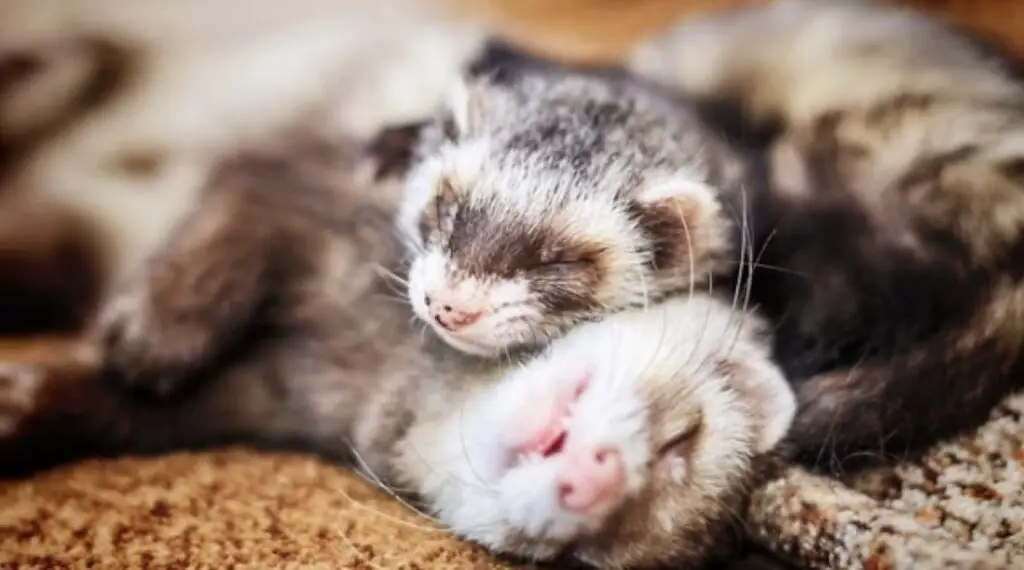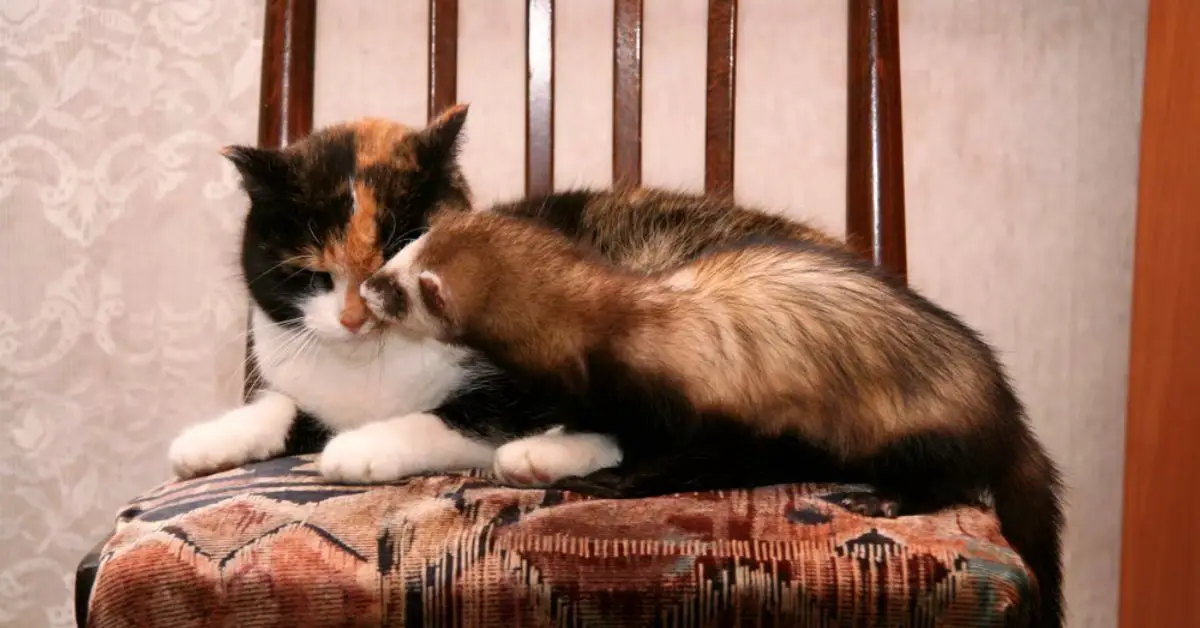Ferrets and cats are two of the most commonly kept pets in households worldwide. While these two animals may seem to be compatible, many pet owners are often left to ponder the question, “can you keep ferrets and cats together?” The answer is not a straightforward one, and it depends on various factors such as the personalities, behaviors, and age of the pets.
In this article, we will explore the ins and outs of keeping ferrets and cats together. We will provide you with valuable insights that will enable you to make informed decisions about whether it’s safe to keep these two animals together and effective ways to introduce them to one another. Whether you’re a seasoned pet owner or a new one, you’ll find this article helpful in creating a harmonious household that both your cats and ferrets will love.
Understanding the Natural Instincts of Ferrets and Cats
Ferrets and cats are both members of the carnivorous family, and they share a lot of similarities in their natural instincts. Both animals are active hunters, and their instincts drive them to chase after small prey that moves quickly.
However, there are also some significant differences between the two animals. Ferrets are more agile and have a more flexible build than cats, which make them more natural escape artists and climbers. Ferrets also have a highly curious nature, which means they can get into things they shouldn’t be in.
Cats, on the other hand, are more solitary animals, and they may view a ferret as an intruder in their territory. They are also more independent and tend to have a higher tolerance for being alone. However, cats can also be territorial, and if they feel that their space is being invaded, they may become aggressive.

When considering keeping ferrets and cats together, it’s essential to understand these natural instincts and tendencies. You need to observe each animal’s behavior carefully and take steps to ensure that they are both safe and comfortable. With proper supervision and training, it is possible to keep ferrets and cats together harmoniously.
Factors to Consider Before Introducing Ferrets and Cats
Before introducing ferrets and cats, it is essential to consider some factors to ensure their safety and happiness. Firstly, you need to understand that ferrets are predators that are closely related to weasels, and this instinct can lead them to attack cats.
Secondly, it is important to assess the personalities of your pets. Ferrets are energetic and playful animals that can become excited and aggressive towards cats, especially if the cat has a shy or timid personality. It is also important to note that young ferrets can be quite rough during playtime, which can result in injuries to your cat.
Thirdly, you should ensure that your home is equipped to handle the presence of both animals. Ferrets require a lot of space to play and explore, while cats need their own personal space to relax and retreat. Therefore, providing both pets with separate areas of the home where they can retreat to when needed is important.
Additionally, feeding habits should be considered before introducing ferrets and cats. Ferrets are obligate carnivores that require a high-protein diet to maintain their health, while cats are also carnivores but require a more balanced diet. Therefore, it is recommended to keep their food bowls separate.
Lastly, it is important to introduce the pets slowly and under close supervision. You should give them time to adjust to each other’s presence before allowing them to interact freely. This will help ensure that they establish a positive relationship and avoid any potential conflicts between the two.
You may also like: How Much Do Black-Footed Ferrets Live?
Introducing Ferrets and Cats: Dos and Don’ts
Introducing ferrets and cats can be a tricky process, and it’s important to take things slow to ensure they get along well. Here are a few dos and don’ts to keep in mind when introducing your ferret and cat:
Dos:
1. Start by keeping your ferret and cat in separate rooms, allowing them to get used to each other’s scent.
2. Use positive reinforcement with both your cat and ferret. Give them treats and praise when they behave well around each other.
3. Always supervise their interactions, especially in the beginning.
4. Gradually introduce them to each other with short, supervised play sessions.
Don’ts:
1. Never leave your ferret and cat alone together unsupervised, as they may get into fights.
2. Never force them to interact if they seem uncomfortable or scared. Start with short, supervised interactions and gradually increase the time they spend together.
3. Don’t punish either pet if they don’t get along at first. This can make things worse and cause even more tension between them.
It may take time, but with patience and proper introductions, ferrets and cats can live together as happy companions.
Signs of a Successful Introduction
Signs of a Successful Introduction
Introducing a ferret to a cat can be a tricky process, but it can be successful with patience and careful supervision. There are some signs that indicate that the introduction is going well.
Firstly, both the cat and ferret are showing curiosity towards each other without any aggression or fear. They may sniff each other and even approach each other without any hostile behavior.
Secondly, the ferret and cat are comfortable being in the same room together. They may not interact directly, but they are relaxed and not showing any fear or aggression towards each other.
Thirdly, the cat and ferret are starting to interact with each other in a positive way. They may start to play together, groom each other, or even cuddle up together.
Fourthly, both animals are using body language that indicates they feel comfortable. The cat may be relaxed with tail up and ears forward, and the ferret may be playful and energetic.
It’s important to keep monitoring the interactions between the cat and ferret even after the successful introduction. Pet owners should always supervise the two animals when they are together, especially in the early stages of their friendship.
In conclusion, if the cat and ferret show positive signs during the introduction and continue to interact well with each other, it’s possible to keep them together in the same household.
Recommended Reading: How Many Ferrets Should You Own?
Common Issues and Solutions When Keeping Ferrets and Cats Together
When keeping ferrets and cats together in the same household, there are common issues that may arise but can be solved with proper management. One of the most common issues is that ferrets have a natural prey drive, which may trigger them to chase and attack cats. This can result in injury or even death to the cat. To prevent this, it’s important to supervise interactions between the two and teach your ferret not to view the cat as prey.
Another issue is that cats may feel threatened by ferrets, causing them to become aggressive towards the ferret. In this case, it’s important to provide each pet with their own personal space and ensure they have separate feeding areas. This will prevent them from feeling threatened and reduce the likelihood of aggression.
Another common issue is the ferret’s tendency to steal and stash items, including the cat’s toys. This can create tension between the two, but it can be managed by providing plenty of toys for both pets and keeping them separate when it comes to feeding.
Finally, it’s important to note that ferrets can carry diseases that are contagious to cats. Make sure to keep both pets up to date on their vaccinations and have any health concerns addressed immediately.
Overall, with proper management and precautions, ferrets and cats can coexist happily in the same household. It just takes a little extra effort to ensure the safety and well-being of both pets.
Ferret and Cat Coexistence: Tips for a Safe and Happy Home
When introducing ferrets and cats, it is important to remember that each animal has its own personality and behavior. While some cats and ferrets may become fast friends, others might not get along well. Here are some tips to ensure that your ferret and cat coexist in a safe and happy home:
1. Supervision: Always supervise your ferret and cat when they are together, at least until you are certain that they are comfortable around each other.
2. Separate living areas: Provide separate living areas for your ferret and cat. Ferrets have different play and sleeping needs than cats, so giving them separate spaces to rest and play will avoid conflicts.
3. Introductions: Introduce your ferret and cat gradually, by letting them sniff each other through a closed door. Gradually move on to supervised interactions.
4. Food: Feed your ferret and cat separately, as ferrets have very different dietary requirements and eating habits than cats.
5. Toys: Provide separate toys for both animals to prevent fighting over them.
6. Grooming: Groom your ferret and cat regularly to prevent hairballs and shedding, which can trigger territorial issues.
7. Behavior: Watch for aggressive or territorial behavior from either animal and seek advice from a veterinarian or animal behaviorist if needed.
By following these tips, you can create a safe and happy home for both your ferret and cat. Remember, it is important to be patient and understanding as it may take some time for the two animals to become comfortable around each other.
More to Explore: Why Can’t I Own A Ferret In California?
Conclusion: Making an Informed Decision About Keeping Ferrets and Cats Together
In conclusion, it is possible to keep ferrets and cats together, but it depends on the individual animals and their personalities. It is important to introduce them slowly and supervise their interactions until they become comfortable with each other.
It is crucial to keep in mind that ferrets have a natural hunting instinct and may see cats as prey, so precautions should be taken to prevent any harm to either animal.
Additionally, providing separate living spaces and hiding places for both animals will reduce stress and potential conflicts.
It is also essential to maintain good hygiene habits as both ferrets and cats can be carriers for certain diseases. Regular cleaning of their living spaces and litter boxes is necessary to keep them healthy.
Ultimately, the decision to keep ferrets and cats together should be based on careful consideration of each animal’s temperament and needs, as well as the owner’s ability to provide proper care and supervision.
If you are unable to ensure the safety and wellbeing of both animals, it may be best to keep them separate. Remember, the happiness and safety of your pets should always come first.
Final thoughts
After thorough research and analysis, it can be concluded that it is possible for ferrets and cats to live together peacefully. However, the process requires proper introduction, socialization, and monitoring.
It is important to remember that every animal has unique behavior and temperament. Therefore, if pet owners decide to keep ferrets and cats together, they must observe any signs of aggression or discomfort and take immediate action. In conclusion, with the right approach, ferrets and cats can coexist in harmony, creating a loving and exciting environment for both pets and their owners.
Further Reading: Why Do Ferrets Dead Sleep?

